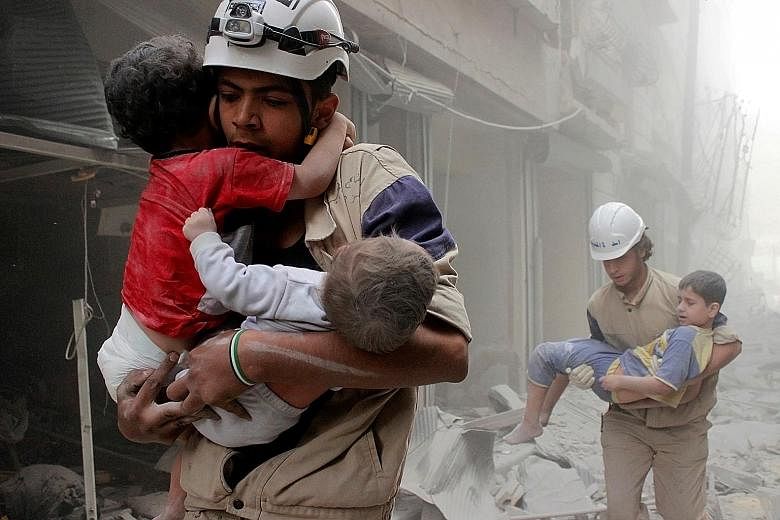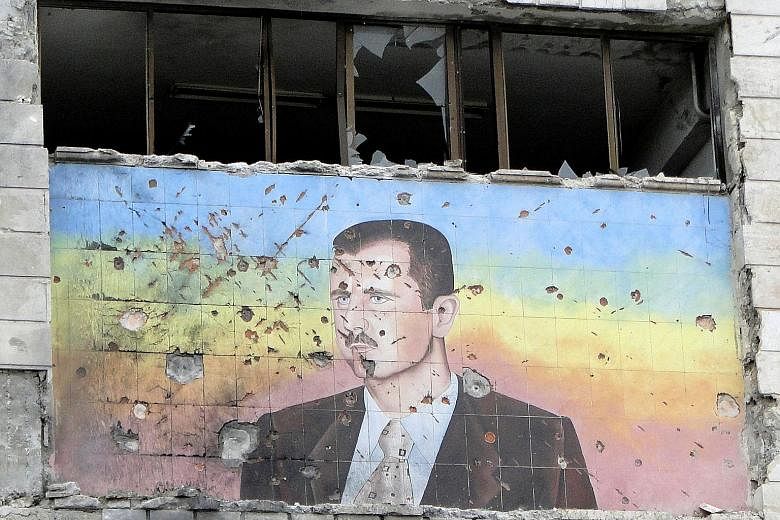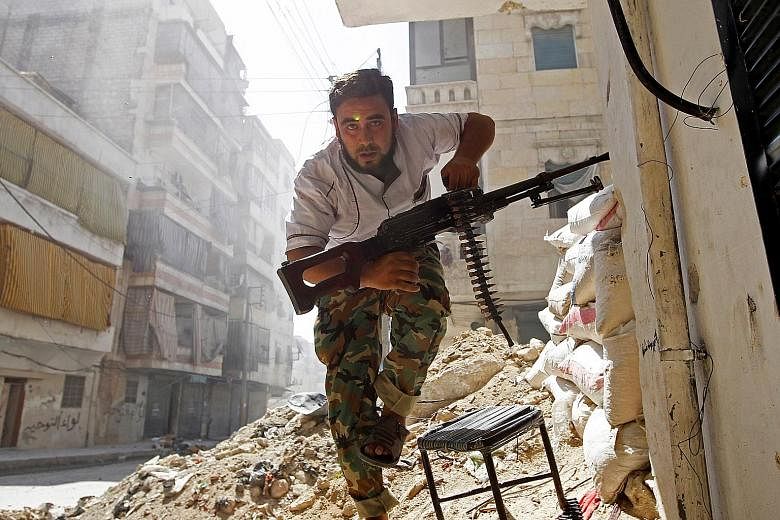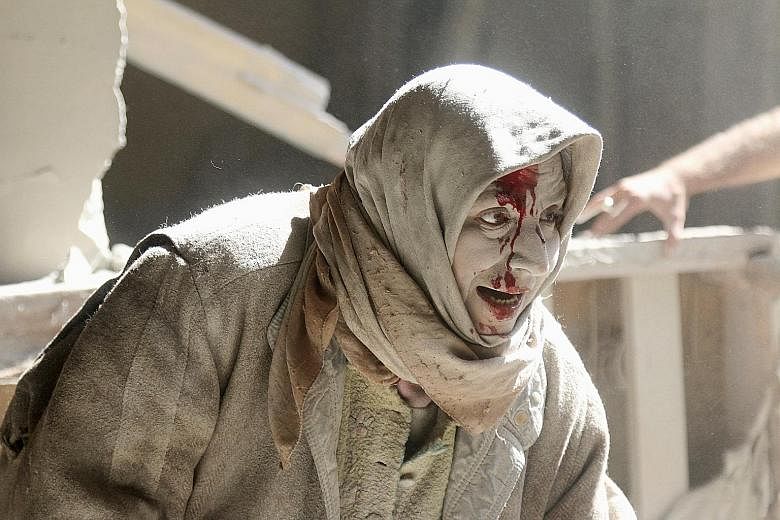BEIRUT • When Syrian rebels surged into Aleppo in the summer of 2012, it was the high point of their still young, still idealistic revolution against President Bashar al-Assad.
Four and a half years and hundreds of thousands of deaths later, troops loyal to Mr Assad's government are poised to take the city back, heralding the end of an era for the rebellion.
With the rebels clinging to a tiny pinprick of territory in one corner of the city, it is now only a matter of time before the government reclaims full control of the country's biggest metropolis, an architectural and historical jewel that has become a symbol of the catastrophe of the Syrian war.
That Mr Assad is in no danger of being toppled has been clear since Russian air strikes last year began turning back rebel gains, putting beyond doubt that the opposition would ever be able to overthrow his regime in Damascus.
The rebels still control large areas of north-western Syria, much of the countryside of southern Syria and several pockets of territory around Damascus and near Homs. But the endgame in Aleppo does change the parameters of the conflict, leaving the rebels with no hold over any strategically significant area of the country and no real bargaining chip to try to force the government into a negotiated settlement.
Coming weeks before the inauguration of a new president in the US, it leaves in shreds the Obama administration's five-year-old policy of using rebel gains to force Mr Assad to compromise.
The bloodshed could now intensify, diplomats fear, as an emboldened government, backed by its Russian and Iranian allies, steps up its efforts to fulfil Mr Assad's promise to reclaim all of the territory lost to the rebels.
Whether they can, at least any time soon, is a different question. It has been three years since government forces turned the tide in Aleppo and began taking back rebel-controlled areas.
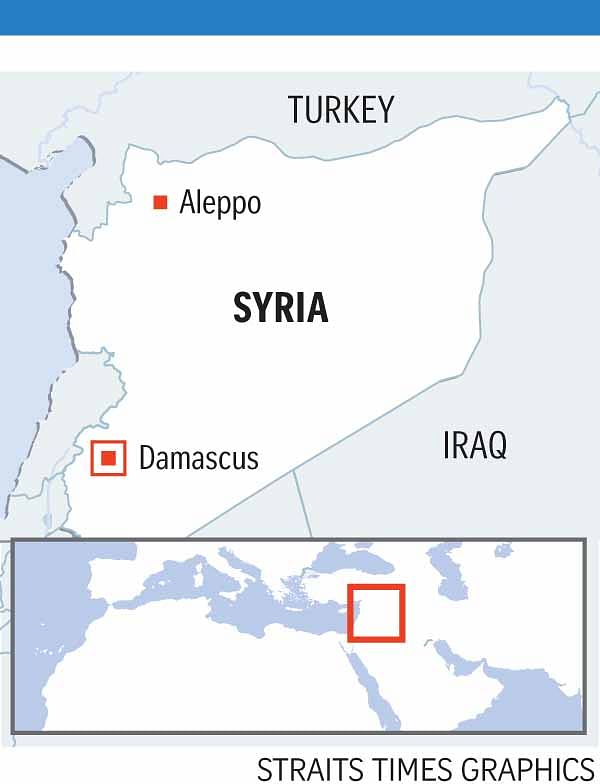
-
Timeline of Aleppo battle
-
2011: Mass demonstrations break out in March in the capital Damascus, with protesters demanding civil rights, political reforms and the release of political prisoners. They soon spread to other cities. A few small protests take place in Aleppo.
2012: Rebels take control of the rural areas north-west of Aleppo city, besieging the Menagh military airbase and the towns of Nubl and Zahra. Protesters in Aleppo are shot at for the first time in July and rebels start to fight for the city itself.
2013: The western, government-held half of Aleppo comes under almost complete siege. But in October, government and allied forces retake it and strengthen their position.
2015: Rebel advances put the government under pressure in north-west Syria, where Aleppo is located. But in October, the first Russian air strikes put the rebels on the back foot.
2016: The army and allies with Russian air support cut the access to the most direct road from Turkey to rebel-held east Aleppo in February, recapturing Menagh airbase, Nubl and Zahra, and putting pressure on insurgent supply routes.
SEPT 22: The heaviest air strikes in months hit east Aleppo. The government announces a new offensive to retake it. OCT 18: After weeks of intense bombardment that hits many hospitals and other civilian infrastructure, Russian and Syrian governments pause their campaign, urging rebels and civilians to quit east Aleppo.
OCT 28: A last rebel offensive to break the siege begins from the countryside to the city's west, but soon loses momentum and all gains reverse within a week.
NOV 15: Intense air strikes resume in east Aleppo. NOV 28: Pro-government forces take the northern part of the rebel sector in a sudden advance, reducing its size by more than a third.
DEC 5 & 6: Another swift advance brings the al-Shaar district and much of Aleppo's historic Old City under government sway, trapping the rebels.
DEC 12: The army makes a series of new advances after taking the Sheikh Saeed district, after days of intense fighting and under a heavy aerial bombardment, leaving rebels stuck in a tiny part of the city.
DEC 13: Insurgents agree to withdraw in a ceasefire deal, which would see them evacuate to rebel-held areas outside Aleppo.
DEC 14: The evacuation does not begin as expected as fierce fighting shakes the city. REUTERS
And the war, which has claimed, by most estimates, at least 400,000 lives, has since become much more complicated.
The Islamic State in Iraq and Sy- ria now controls more than a third of the eastern part of the country, and has drawn the United States into Syria's war. While attention was focused on the battle for Aleppo, the militants recaptured the Syrian city of Palmyra, overrunning in just three days loyalist positions that had been depleted by diversions to the Aleppo front.
Syrian Kurds are now governing a big area in north-eastern Syria that Mr Assad has also said he wants to reclaim. Turkish troops have intervened in another area of the north of the country and control a chunk of territory alongside a force of allied rebels.
"Two things are absolutely clear here," said a US official, speaking on condition of anonymity.
"One, the regime doesn't have capability to end this war, even with Russia's backing, and the scorched- earth approach it is taking is only going to attract more extremists."
Aleppo will nonetheless be remembered as a symbolic milestone, the final death of a dream of a more democratic Syria that had waned long ago. The brutality of the government crackdown and the reluctance of world powers to pressure the Assad regime into softening its tactics exposed shortcomings in the global system of laws and norms designed to ameliorate the suffering of civilians in war.
Aleppo represents "the death of respect for international law and the rules of war", according to Mr David Miliband, who heads the International Rescue Committee, an aid agency.
And Aleppo also became a symbol of the failures of the Syrian revolution, which began with peaceful protests against a dictatorial regime but mutated into an armed rebellion that also violated many of those international rules.
Syrian state television broadcast live footage throughout Tuesday showing its reporters roaming the ruins of the newly reconquered neighbourhoods, trumpeting the government's victory as they climbed over piles of rubble, peered into abandoned homes and sifted through the remains of rebel defences. There was no other sign of life in the empty streets.
A ceasefire brokered on Tuesday by Russia and Turkey all but collapsed yesterday with the resumption of air strikes, shelling and gunfire .
WASHINGTON POST, REUTERS
